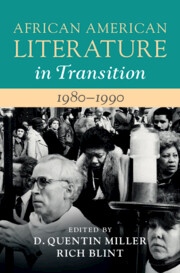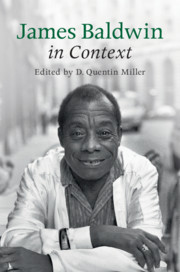36 results
3 - Wideman’s Family Stories and the Carceral Archipelago
- from Part I - The Expanding Canon
-
-
- Book:
- African American Literature in Transition, 1980–1990
- Published online:
- 02 February 2023
- Print publication:
- 09 February 2023, pp 56-76
-
- Chapter
- Export citation
Copyright page
-
- Book:
- African American Literature in Transition, 1980–1990
- Published online:
- 02 February 2023
- Print publication:
- 09 February 2023, pp iv-iv
-
- Chapter
- Export citation
Index
-
- Book:
- African American Literature in Transition, 1980–1990
- Published online:
- 02 February 2023
- Print publication:
- 09 February 2023, pp 257-260
-
- Chapter
- Export citation
Contents
-
- Book:
- African American Literature in Transition, 1980–1990
- Published online:
- 02 February 2023
- Print publication:
- 09 February 2023, pp v-vi
-
- Chapter
- Export citation
Introduction
-
-
- Book:
- African American Literature in Transition, 1980–1990
- Published online:
- 02 February 2023
- Print publication:
- 09 February 2023, pp 1-10
-
- Chapter
- Export citation
Notes on Contributors
-
- Book:
- African American Literature in Transition, 1980–1990
- Published online:
- 02 February 2023
- Print publication:
- 09 February 2023, pp vii-xii
-
- Chapter
- Export citation
Part II - New Directions/New Literary Forms
-
-
- Book:
- African American Literature in Transition, 1980–1990
- Published online:
- 02 February 2023
- Print publication:
- 09 February 2023, pp 119-182
-
- Chapter
- Export citation

African American Literature in Transition, 1980–1990
-
- Published online:
- 02 February 2023
- Print publication:
- 09 February 2023
Part 3 - Literary Contexts
-
- Book:
- James Baldwin in Context
- Published online:
- 12 July 2019
- Print publication:
- 01 August 2019, pp 199-321
-
- Chapter
- Export citation
Part 2 - Social and Cultural Contexts
-
- Book:
- James Baldwin in Context
- Published online:
- 12 July 2019
- Print publication:
- 01 August 2019, pp 125-198
-
- Chapter
- Export citation
Contents
-
- Book:
- James Baldwin in Context
- Published online:
- 12 July 2019
- Print publication:
- 01 August 2019, pp v-vii
-
- Chapter
- Export citation
Index
-
- Book:
- James Baldwin in Context
- Published online:
- 12 July 2019
- Print publication:
- 01 August 2019, pp 322-328
-
- Chapter
- Export citation
Chapter 21 - Baldwin and the Rhetoric of Confession
- from Part 3 - Literary Contexts
-
-
- Book:
- James Baldwin in Context
- Published online:
- 12 July 2019
- Print publication:
- 01 August 2019, pp 221-232
-
- Chapter
- Export citation
Chapter 2 - American Writers in Paris
- from Part 1 - Life and Afterlife
-
-
- Book:
- James Baldwin in Context
- Published online:
- 12 July 2019
- Print publication:
- 01 August 2019, pp 17-27
-
- Chapter
- Export citation
Copyright page
-
- Book:
- James Baldwin in Context
- Published online:
- 12 July 2019
- Print publication:
- 01 August 2019, pp iv-iv
-
- Chapter
- Export citation
Contributors
-
- Book:
- James Baldwin in Context
- Published online:
- 12 July 2019
- Print publication:
- 01 August 2019, pp viii-xiv
-
- Chapter
- Export citation
Chapter 10 - Biographies
- from Part 1 - Life and Afterlife
-
-
- Book:
- James Baldwin in Context
- Published online:
- 12 July 2019
- Print publication:
- 01 August 2019, pp 105-116
-
- Chapter
- Export citation
Introduction: James Baldwin in Context
-
-
- Book:
- James Baldwin in Context
- Published online:
- 12 July 2019
- Print publication:
- 01 August 2019, pp 1-4
-
- Chapter
- Export citation
Part 1 - Life and Afterlife
-
- Book:
- James Baldwin in Context
- Published online:
- 12 July 2019
- Print publication:
- 01 August 2019, pp 5-124
-
- Chapter
- Export citation

James Baldwin in Context
-
- Published online:
- 12 July 2019
- Print publication:
- 01 August 2019



